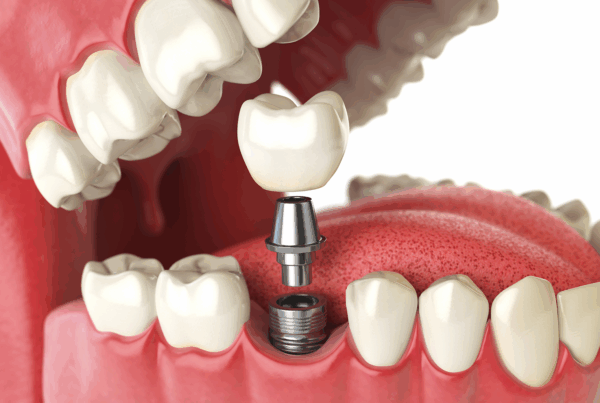Life happens. Teeth get chipped, cavities sneak in, old fillings wear out, and accidents take their toll. But none of this means you have to live with discomfort or insecurity. Restorative dentistry is all about fixing what’s broken, worn down, or missing, so you can eat, speak, and smile without hesitation.
At Encino Dental Studio, we treat restorative work as more than just patching up a problem. It’s about bringing your teeth back to full strength, appearance, and function with skill, care, and attention to detail. Whether you’re dealing with a single chipped tooth or multiple missing ones, restorative dentistry offers solutions that are both practical and life-changing.
What is the difference between restorative and cosmetic dentistry?
It’s easy to mix the two up, especially since many treatments can overlap. But the purpose behind each one is what sets them apart.
Restorative dentistry focuses on repairing damage. If you’ve got a cracked tooth, decay, or a missing molar, the goal is to fix it so your mouth works the way it should. Procedures like fillings, crowns, bridges, and implants fall under this umbrella.
Cosmetic dentistry, on the other hand, is more about aesthetics. Think of teeth whitening, veneers, or reshaping a tooth that’s perfectly healthy but doesn’t quite look the way you want.
Here’s a simple way to think about it:
- If the procedure is necessary to restore health or function, it’s restorative.
- If the procedure is optional and improves appearance, it’s cosmetic.
That said, many restorative procedures also boost your smile’s appearance. Crowns can make a tooth look brand new. Implants restore your bite and give you a natural-looking replacement. So while the primary goal is function, you get a visual upgrade too.
 The most common restorative treatments
The most common restorative treatments
Restorative dentistry isn’t a one-size-fits-all field. Your dentist will look at the condition of your teeth and recommend what works best for your needs. Here are the treatments you’ll hear about most often:
Fillings
This is the most common and often the simplest restorative procedure. If decay has created a cavity, your dentist will remove it and fill the hole with a durable material. Composite (tooth-colored) fillings are popular for their natural look.
Crowns
Crowns are custom-made caps that cover a damaged or weakened tooth. They’re often used after a large filling or root canal and can be made from porcelain, metal, or a combination of both.
Bridges
A bridge replaces one or more missing teeth by anchoring to the surrounding teeth. It’s a permanent solution that restores your bite and helps prevent shifting.
Dental Implants
For those who want a long-lasting and natural-feeling replacement for a lost tooth, implants are the gold standard. A titanium post is placed in the jawbone, topped with a realistic-looking crown.
Root Canals
When the pulp inside your tooth becomes infected or inflamed, a root canal can save the tooth. The procedure removes the damaged tissue, cleans the canal, and seals it up before placing a crown.
Dentures
For patients missing several or all teeth, partial or full dentures can restore your ability to eat and speak properly. Modern dentures are more comfortable and lifelike than ever.
 How long do dental crowns, bridges, or fillings typically last?
How long do dental crowns, bridges, or fillings typically last?
There’s no single answer, because it depends on a few things: the material used, how well you care for your teeth, and even how you bite or grind. That said, here’s a general breakdown:
- Fillings: Composite fillings can last 5 to 10 years on average, while amalgam (metal) fillings might last a little longer.
- Crowns: A porcelain crown typically lasts 10 to 15 years, but with excellent care, it can go beyond 20.
- Bridges: Dental bridges usually last between 5 and 15 years, depending on how well you maintain your oral hygiene and the health of the surrounding teeth.
To get the most life out of your restorations:
- Brush twice a day with a soft-bristled toothbrush
- Floss daily, especially around crowns or bridges
- Don’t chew hard items like ice or pens
- Visit your dentist regularly to catch any early issues
Nothing lasts forever, but a well-made restoration combined with solid oral care can serve you for years.
 Restorative dentistry and quality of life
Restorative dentistry and quality of life
Restoring a tooth does more than stop pain or fill a gap. It gives you confidence to smile again, makes it easier to enjoy meals, and improves your long-term oral health.
Missing teeth can lead to jawbone loss over time. A cracked tooth can worsen and eventually require extraction. Gum inflammation around a damaged area can affect surrounding teeth. In short, waiting often makes things worse.
But here’s the good news: restorative dentistry can stop that domino effect in its tracks. It reinforces weak teeth, replaces what’s gone, and makes your mouth feel whole again.
Is restorative dental work covered by insurance?
Most dental insurance plans do offer some level of coverage for restorative procedures, especially when the work is considered medically necessary. Here’s what you can typically expect:
- Fillings: Often covered partially or fully by most plans
- Crowns: Usually covered up to a certain percentage
- Bridges and dentures: Typically covered, though sometimes with waiting periods
- Implants: Less commonly covered, but some plans are starting to include partial coverage or reimbursements
The exact coverage depends on your specific provider and plan. Some policies cap the annual amount they’ll pay, while others may classify certain treatments as elective.
It’s always best to check with your insurance provider ahead of time. At Encino Dental Studio, our team is happy to help you understand your benefits and handle any pre-approvals or paperwork needed.
 When should you see a dentist for restorative treatment?
When should you see a dentist for restorative treatment?
If you’ve been putting off that broken tooth or nagging pain, now’s the time to act. The earlier a problem is caught, the more options you’ll have—and the simpler the fix.
Here are a few signs you might need restorative dental care:
- Pain when chewing or biting
- Teeth that feel loose or have visible cracks
- Food getting trapped in a specific area
- Sensitivity to hot or cold
- Gaps from missing teeth
- Older fillings or crowns that feel worn or uncomfortable
Even if nothing hurts, it’s worth getting checked if something feels off. Dental issues often start silently, and catching them early can save you time, money, and more involved treatment down the line.
What to expect during your appointment
The process typically starts with a conversation and an exam. At Encino Dental Studio, we’ll listen to your concerns, take X-rays if needed, and walk you through your treatment options. We’ll also discuss the pros and cons of each approach, as well as any costs or timelines.
We know it can feel overwhelming, especially if you haven’t been to the dentist in a while. But you’ll never be judged here. Our focus is on getting you back to full oral health at a pace that works for you.
 Final thoughts
Final thoughts
Restorative dentistry isn’t just about fixing teeth. It’s about restoring comfort, function, and confidence. Whether it’s a simple filling or a more complex dental implant, every treatment brings you one step closer to a healthier, happier smile.
If something’s bothering you or you just know it’s time to take care of your teeth, don’t wait. We’re here to help.
Ready to restore your smile?
Book your appointment today at Encino Dental Studio and take the first step toward feeling like yourself again.







